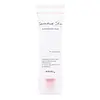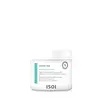What's inside
What's inside
 Key Ingredients
Key Ingredients

 Benefits
Benefits

 Concerns
Concerns

No concerns
 Ingredients Side-by-side
Ingredients Side-by-side

Water
Skin ConditioningSqualane
EmollientIsononyl Isononanoate
EmollientGlycerin
HumectantButylene Glycol
HumectantPEG-100 Stearate
Xanthan Gum
EmulsifyingCarbomer
Emulsion StabilisingHexanediol
SolventCaprylyl Glycol
EmollientTrehalose
HumectantSodium Hyaluronate
HumectantCollagen
MoisturisingAminomethyl Propanol
BufferingAloe Barbadensis Leaf Juice Powder
Skin ConditioningCentella Asiatica Extract
CleansingPolygonum Cuspidatum Root Extract
AntioxidantScutellaria Baicalensis Root Extract
AstringentCamellia Sinensis Leaf Extract
AntimicrobialGlycyrrhiza Glabra Root Extract
BleachingChamomilla Recutita Flower Extract
MaskingRosmarinus Officinalis Leaf Extract
AntimicrobialPanicum Miliaceum Seed Extract
Skin ConditioningLactobacillus Ferment
Skin ConditioningPolyquaternium-51
Skin ConditioningSodium Benzoate
MaskingPotassium Sorbate
PreservativeWater, Squalane, Isononyl Isononanoate, Glycerin, Butylene Glycol, PEG-100 Stearate, Xanthan Gum, Carbomer, Hexanediol, Caprylyl Glycol, Trehalose, Sodium Hyaluronate, Collagen, Aminomethyl Propanol, Aloe Barbadensis Leaf Juice Powder, Centella Asiatica Extract, Polygonum Cuspidatum Root Extract, Scutellaria Baicalensis Root Extract, Camellia Sinensis Leaf Extract, Glycyrrhiza Glabra Root Extract, Chamomilla Recutita Flower Extract, Rosmarinus Officinalis Leaf Extract, Panicum Miliaceum Seed Extract, Lactobacillus Ferment, Polyquaternium-51, Sodium Benzoate, Potassium Sorbate
Water
Skin ConditioningGlycerin
HumectantCocos Nucifera Fruit Juice
EmollientCocos Nucifera Water
MaskingBetaine
HumectantTrehalose
HumectantSodium Hyaluronate
HumectantBeta-Glucan
Skin ConditioningXanthan Gum
EmulsifyingBrassica Oleracea Italica Sprout Extract
EmollientLaminaria Japonica Extract
Skin ProtectingSalicornia Herbacea Extract
Skin ConditioningSargassum Fulvellum Extract
Skin ConditioningGelidium Cartilagineum Extract
Skin ProtectingRosmarinus Officinalis Extract
AntimicrobialMelaleuca Viridiflora Leaf Oil
Skin ConditioningChamomilla Recutita Flower/Leaf Extract
AntimicrobialCentella Asiatica Extract
CleansingCalendula Officinalis Flower Extract
MaskingCitrus Aurantium Bergamia Fruit Oil
MaskingLactobacillus/Soybean Ferment Extract
Skin ConditioningSalix Alba Bark Extract
AstringentCinnamomum Cassia Bark Extract
MaskingOriganum Vulgare Leaf Extract
Skin ConditioningChamaecyparis Obtusa Leaf Extract
Skin ConditioningScutellaria Baicalensis Root Extract
AstringentPortulaca Oleracea Extract
Skin ConditioningAcorus Calamus Root Extract
PerfumingGlycine Soja Seed Extract
Skin ConditioningSesamum Indicum Seed Extract
Skin ConditioningCamellia Sinensis Leaf Extract
AntimicrobialArginine
MaskingAllantoin
Skin ConditioningPanthenol
Skin ConditioningCarbomer
Emulsion StabilisingPaeonia Suffruticosa Root Extract
Skin ProtectingGlycyrrhiza Glabra Root Extract
BleachingWater, Glycerin, Cocos Nucifera Fruit Juice, Cocos Nucifera Water, Betaine, Trehalose, Sodium Hyaluronate, Beta-Glucan, Xanthan Gum, Brassica Oleracea Italica Sprout Extract, Laminaria Japonica Extract, Salicornia Herbacea Extract, Sargassum Fulvellum Extract, Gelidium Cartilagineum Extract, Rosmarinus Officinalis Extract, Melaleuca Viridiflora Leaf Oil, Chamomilla Recutita Flower/Leaf Extract, Centella Asiatica Extract, Calendula Officinalis Flower Extract, Citrus Aurantium Bergamia Fruit Oil, Lactobacillus/Soybean Ferment Extract, Salix Alba Bark Extract, Cinnamomum Cassia Bark Extract, Origanum Vulgare Leaf Extract, Chamaecyparis Obtusa Leaf Extract, Scutellaria Baicalensis Root Extract, Portulaca Oleracea Extract, Acorus Calamus Root Extract, Glycine Soja Seed Extract, Sesamum Indicum Seed Extract, Camellia Sinensis Leaf Extract, Arginine, Allantoin, Panthenol, Carbomer, Paeonia Suffruticosa Root Extract, Glycyrrhiza Glabra Root Extract
Ingredients Explained
These ingredients are found in both products.
Ingredients higher up in an ingredient list are typically present in a larger amount.
Camellia Sinensis Leaf Extract is derived from the leaves of the tea plant. Black tea, green tea, and oolong tea are all harvested from this plant.
This ingredient has many skin benefits:
This ingredient contains polyphenols, a strong antioxidant. Antioxidants help fight off molecules that damage skin cells.
On top of that, the antioxidants in green tea neutralize free-radicals from the sun. This gives the skin some extra UV protection, but should not replace sunscreen.
Many components of tea have anti-inflammatory properties.
Polyphenols and L-theanine help soothe the skin and reduce irritation. The caffeine in Camellia Sinensis Leaf Extract helps calm inflamed blood vessels.
Other compounds found in tea include: Vitamin Bs, linoleic acid, magnesium, calcium, iron, and zinc.
Research has shown both drinking Camellia Sinensis Leaf Tea and applying it to the skin can help boost skin elasticity and hydration. Studies also show using tea extract may reduce sebum, or oil, production.
Learn more about Camellia Sinensis Leaf ExtractCarbomer is a polymer of acrylic acid. Its main role is to create a gel consistency.
A high amount of carbomer can cause pilling or balling up of products. Don't worry, most products contain 1% or less of carbomer.
Centella Asiatica Extract (Centella) is derived from an herb native to Southeast Asia. It is famous for its anti-inflammatory and soothing properties.
Centella is rich in antioxidants and amino acids, such as Madecassic Acid and Asiaticoside.
Studies show the compounds in centella help with:
The combination of all these properties makes centella effective at soothing, hydrating, and protecting the skin.
Other great components of centella include Vitamin A, vitamin C, several B vitamins, and Asiatic Acid.
Fun fact: Centella has been used as a medicine and in food for many centuries. As a medicine, it is used to treat burns, scratches, and wounds.
Learn more about Centella Asiatica ExtractGlycerin is already naturally found in your skin. It helps moisturize and protect your skin.
A study from 2016 found glycerin to be more effective as a humectant than AHAs and hyaluronic acid.
As a humectant, it helps the skin stay hydrated by pulling moisture to your skin. The low molecular weight of glycerin allows it to pull moisture into the deeper layers of your skin.
Hydrated skin improves your skin barrier; Your skin barrier helps protect against irritants and bacteria.
Glycerin has also been found to have antimicrobial and antiviral properties. Due to these properties, glycerin is often used in wound and burn treatments.
In cosmetics, glycerin is usually derived from plants such as soybean or palm. However, it can also be sourced from animals, such as tallow or animal fat.
This ingredient is organic, colorless, odorless, and non-toxic.
Glycerin is the name for this ingredient in American English. British English uses Glycerol/Glycerine.
Learn more about GlycerinGlycyrrhiza Glabra Root Extract is an extract of the roots of Licorice. It has been found to have several benefits such as skin hydrating, conditioning, and soothing.
One component, glabridin, has extra potent antioxidant and soothing properties. It has also been found to block pigmentation from UVB rays in guinea pigs.
Licorice Root also contains a flavonoid. Flavonoids are a natural substance from in plants. Flavonoids also have antioxidant properties.
Another component, glycyrrhizin, has been found to have anti-inflammatory and antimicrobial benefits. This may make licorice root extract effective at treating acne. However, more research is needed to support this.
Liquiritin is one of the flavone compounds found in licorice. It has been found to help lighten skin by preventing tyrosinase from reacting with tyrosine. When the two react, protein is converted to melanin. Melanin is the substance in your body that gives your features pigmentation.
Learn more about Glycyrrhiza Glabra Root ExtractScutellaria Baicalensis Root Extract comes from the Baikal skullcap or Chinese skullcap plant. This plant is native to Northeast Asia and can be found in China, Mongolia, Korea, and Siberia.
In cosmetics, Scutellaria Baicalensis Root Extract provides antioxidant and anti-inflammatory benefits. This is due to the flavonoid composition of Scutellaria Baicalensis Root Extract.
In Chinese traditional folk medicine, Scutellaria Baicalensis Root Extract is used to help treat lung issues and hypertension.
Learn more about Scutellaria Baicalensis Root ExtractSodium Hyaluronate is hyaluronic acid's salt form. It is commonly derived from the sodium salt of hyaluronic acid.
Like hyaluronic acid, it is great at holding water and acts as a humectant. This makes it a great skin hydrating ingredient.
Sodium Hyaluronate is naturally occurring in our bodies and is mostly found in eye fluid and joints.
These are some other common types of Hyaluronic Acid:
Learn more about Sodium HyaluronateTrehalose is a disaccharide made of two glucose molecules (glucose is sugar!). Trehalose is used to help moisturize skin. It also has antioxidant properties.
As a humectant, trehalose helps draw moisture from the air to your skin. This helps keep your skin hydrated.
Due to its antioxidant properties, trehalose may help with signs of aging. Antioxidants help fight free-radical molecules, unstable molecules that may damage your skin.
In medicine, trehalose and hyaluronic acid are used to help treat dry eyes.
Some animals, plants, and bacteria create trehalose as a source of energy to survive freeze or lack of water.
Learn more about TrehaloseWater. It's the most common cosmetic ingredient of all. You'll usually see it at the top of ingredient lists, meaning that it makes up the largest part of the product.
So why is it so popular? Water most often acts as a solvent - this means that it helps dissolve other ingredients into the formulation.
You'll also recognize water as that liquid we all need to stay alive. If you see this, drink a glass of water. Stay hydrated!
Learn more about WaterXanthan gum is used as a stabilizer and thickener within cosmetic products. It helps give products a sticky, thick feeling - preventing them from being too runny.
On the technical side of things, xanthan gum is a polysaccharide - a combination consisting of multiple sugar molecules bonded together.
Xanthan gum is a pretty common and great ingredient. It is a natural, non-toxic, non-irritating ingredient that is also commonly used in food products.
Learn more about Xanthan Gum